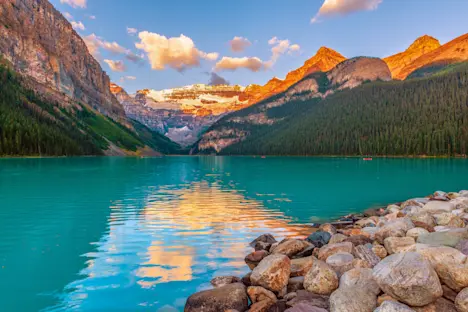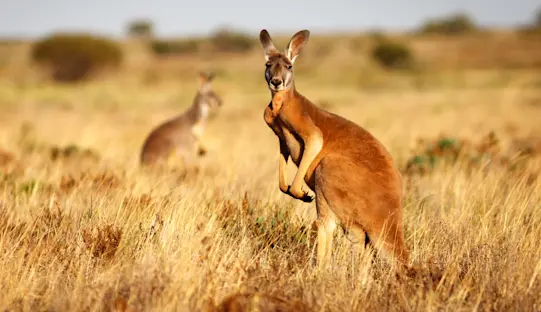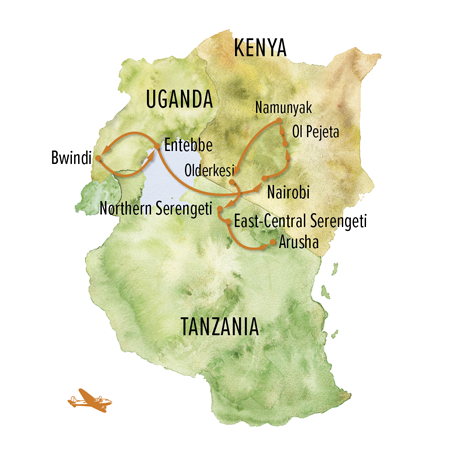2026 Itinerary
Upon your arrival in Entebbe, our Expedition Leader meets you at the airport. Transfer to our boutique hotel, a refuge set amid lush gardens in this peaceful city that was the capital of Uganda during colonial times. This evening, enjoy a welcome dinner with traveling companions and our expert naturalist guide who is with you throughout your entire journey.

Fly from Entebbe to Kihihi and transfer to our rainforest ecolodge on the edge of Bwindi Impenetrable National Park. This UNESCO World Heritage Site is one of the world's most famous destinations for gorilla trekking. Bwindi is home to nearly half the world’s mountain gorillas—about 460—a population that is growing but still threatened by increasing human presence in the surrounding communities. We may even catch our first glimpse of mountain gorillas right on the grounds of the lodge, since many trails into the park's dense jungle, which early explorers called the “Impenetrable Forest,” leave directly from here. Responsible tourism has been integral to sustaining critically endangered gorillas, and the dollars we infuse into the local community help support their protection by sustaining the people who live near them.
Spend two full days tracking gorillas in Bwindi Impenetrable National Park. Rise early each morning in anticipation of a peerless experience: the chance to look into the face of a wild gorilla. After an early breakfast, make a short drive to park headquarters to meet our local guides who provide an orientation to the day's trek, covering the etiquette of behavior among the gorillas. From here, we walk or drive a short distance to the trek starting point, then head into the emerald rainforest on foot, accompanied by local guides.
The trackers are out on the mountain ahead of our departure, identifying where the gorillas were seen the night before and pursuing them to a point where we are able to connect. Reaching the gorillas' current location can take as little as 15 minutes or up to several hours, depending on how far the gorilla family has traveled. The trek may involve climbing to altitudes above 7,500 feet over terrain is rough and at times muddy, though the rewards are profound. While the hike can be physically demanding, the beauty of the forest en route makes it worthwhile. Once we find the gorillas, all fatigue is forgotten, and the experience is often described as the most profound nature encounter travelers have ever experienced. If time permits, we’ll visit Conservation Coffee, a local co-op of farmers who grow, process and roast beans to sell at a premium to benefit gorilla conservation. We may have a chance to walk through the coffee fields, pick some beans, and witness this sustainable community enterprise firsthand.
Fly from Kihihi back to Entebbe this morning to connect with our flight to Kenya's capital of Nairobi. From the airport, transfer to the House of Waine, located in the quiet residential suburb of Karen on the outskirts of the city. Originally built as a lavish private estate, today the stately home surrounded by lush gardens is one of Nairobi's most elegant boutique hotels. It sits at the foot of the Ngong Hills, an area made famous in Isak Dinesen's well-known memoir Out of Africa.
Fly north to the renowned Ol Pejeta Conservancy, located on the Laikipia Plateau in the shadow of Mount Kenya. A working cattle ranch established in the 1940s during Kenya's colonial days, Ol Pejeta set aside land for rhino conservation in 1988 and has become a highly regarded trailblazer for conservation innovation. Today it is the largest black rhino sanctuary in East Africa and home to the world’s last two remaining northern white rhinos, a staunchly guarded pair of females that we visit in person. The conservancy is also home to the endangered Grevy's zebra and has some of Kenya's highest predator densities, yet it still manages a very successful livestock program. Ol Pejeta seeks to preserve the exceptional biodiversity within its 90,000 acres while supporting the people living on its borders, to ensure that wildlife conservation translates to better education, healthcare and infrastructure for the next generation of wildlife guardians. In 2014, Ol Pejeta achieved IUCN Green List status, one of only two conservancies in Africa to be so recognized. The Green List aims to define excellence in managing valuable natural areas.
Nat Hab's Rhino Camp inside the conservancy is the ideal base from which to explore this diverse wildlife haven that contains many of Kenya's endemic northern species. We'll hope to see the legendary Big Five and much more on day and night wildlife drives and guided walks against the backdrop of snowcapped Mount Kenya. At the end of each exhilarating foray into the bush, return to the comforts of our tented camp, redolent with the ambience of East Africa's classic safari era.
A short chartered flight takes us to the Namunyak Community Conservancy in the heart of Kenya’s northern frontier. Backdropped by the dramatic Mathews Range, this land is home to the Samburu people, semi-nomadic pastoralists who have raised livestock here for centuries while coexisting in harmony with the region’s striking wildlife. Namunyak is one of Kenya’s most pristine wilderness areas, serving as a critical refuge for many wildlife species, with important northern populations of reticulated giraffe, gerenuk, leopard, African wild dog, impala lion, greater kudu and many different birds. The conservancy is particularly important for elephants as they move seasonally between the Mathews Range and the Ngare Ndare Forest near Mount Kenya, a route they have used for decades.
Our base for exploration is Nat Hab’s Elephant Conservation Camp, where seclusion, comfort and exceptional service are hallmarks of this exclusive experience. Our stay includes a private visit to Reteti Elephant Sanctuary, the world’s first such enterprise owned by Indigenous community members. The sanctuary was designed to rescue and release orphaned and abandoned elephant calves while creating much-needed benefits for the local people that live alongside them—inspiring them to recognize the intrinsic value of nature and protecting local wildlife for its benefit to their own well-being.
We have the rare opportunity to go behind the scenes to meet the dedicated local caretakers and to witness firsthand how Reteti is transforming elephant conservation. Observe feeding time, learn the elephants’ individual stories, and support a model of conservation that uplifts both wildlife and the surrounding Samburu community. We’ll also take game drives and guided bush walks to look for roaming elephants and other wildlife, punctuated with peaceful interludes at camp. The entire experience offers a soulful connection to northern Kenya’s people, animals and landscapes—one that few travelers are privileged to encounter, and one that will certainly ignite your own passion for conservation.
Fly this morning to the Maasai Mara, one of Africa’s most legendary wildlife realms. Secluded within the vast private conservancy that borders the Maasai Mara National Reserve, our isolated tented camp is surrounded by all the wonders of the Mara ecosystem without the crowds. With strict limits on guest numbers, the 7,000-acre Olderkesi Community Wildlife Conservancy offers the rare opportunity to experience the Mara’s spectacular wildlife in peaceful seclusion, especially the wildebeest migration. The conservancy serves as a migration corridor for thousands of animals moving between the Maasai Mara National Reserve and the Loita Plains to the east. It is a successful model for how local people are integrating agricultural livelihoods with wildlife protection. By limiting development to certain areas and keeping vast tracts of collectively owned grazing land open and unfenced, Maasai landowners enable wildlife to move freely while also reducing human-wildlife conflict at their homesteads.
As a result, a multitude of species flourishes on the conservancy. Herds of antelope dot the rolling plains while stands of acacia trees shelter prolific birdlife. Rich volcanic soils nurture the grassy savanna where we find more lions per square mile than anywhere else in Kenya. Prolific herds of elephant, giraffe and zebra are also on view. Our activities make the most of our unrivaled access to this wide-open wild country. In addition to daily wildlife drives, enjoy guided bush walks, wilderness picnics, off-road safaris and night drives in search of nocturnal wildlife—exciting activities not permitted in the adjacent national reserve.

Fly to the Serengeti Plains, the Tanzanian side of the massive Mara-Serengeti ecosystem. The sweeping sea of grass that comprises Serengeti National Park is roughly the size of Maryland, and its reputation as one of the world’s iconic nature destinations is well deserved. Staggering concentrations of hoofed game and prodigious predators engage in an ancient and epic struggle for survival. Nat Hab's private mobile camp provides a front-row view on all the action, as well as the romance of sleeping under canvas beneath starry African skies.
We spend three days in the remote northern reaches of the Serengeti, immersed in the phenomenon of the Great Migration. In accord with the animals' movement patterns, our mobile camp is placed in a main migration corridor traversed by more than 2 million wildebeest, zebra and gazelle, plus an accompanying cast of predators, on their annual 1,800-mile trek from Kenya’s Maasai Mara to the southern Serengeti and back again. Witness this remarkable spectacle on daily game drives, where we may behold stunning scenes of predator-prey interaction as a lion takes down a sick wildebeest or a cheetah overtakes an infant antelope. We track the herds in private 4x4 vehicles, allowing for optimal mobility and proximity.
Our luxury mobile camp is placed where the wildlife is, yet we retreat to surprising comfort given the remoteness of our location. Walk-in canvas tents are reminiscent of the safari era of yesteryear, offering superb ambience and seclusion. Each evening, dine under a canopy of stars and share impressions of the day around a crackling campfire.
Fly to the eastern Serengeti today for a two-night stay at our exclusive bush camp. Surrounded by open range and kopjes—large granite outcrops that dot the plains—our private camp offers fabulous wildlife viewing in diverse habitats, particularly of the abundant feline predators that live and hunt in this area. It also provides exceptional privacy away from crowds. From canvas tents shaded by giant acacia trees, survey 360-degree views of wildlife traversing the savanna, with more thrilling encounters in store on game drives.
The surrounding environs are dotted with dramatic rocky outcrops, and the sunrise over these granite kopjes is glorious. Shaded by giant acacias, our camp lies where the short-grass plains meet acacia woodlands. The nearby Nyabogati River sustains year-round wildlife concentrations. From this secluded outpost we can expect unrivaled sightings of the big cats that are so plentiful in this area. Until recently, this area was set aside for scientific research into predators, especially cheetah, but today, we are able to enjoy that same access to this dense feline population. Such close encounters with the Serengeti’s apex predators are sure to enthrall even the most seasoned safari traveler.
This morning we fly back to Arusha and transfer to Ngare Sero Lodge at the base of Mount Meru, where a farewell lunch is served on arrival. Day rooms await in this peaceful setting, offering a chance to relax and refresh before your transfer to Kilimanjaro Airport for international departures this evening.

































